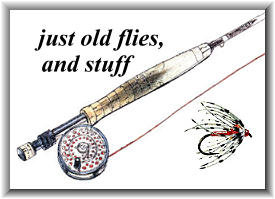"This popular fly is a native of Canada. Though questionable,
this pattern is credited to Peter Cowan, of Cowansville,
Sheriff, 1866-80, of the District of Bedford, consisting
of the counties of Brome, Missisquoi and Shefford, in the
Province of Quebec. The fly was named by the flymaker in
Montreal who first tied it commercially.
The fly dates about 1840.
There appear to have been two styles of dressing. The
more popular, and as we know it, was the claret hackle;
gold tinsel wound spirally around the claret body, and
brown mallard wings. The original pattern was make with
a "red body, ribbed with yellow tinsel, the hackle assorted
scarlet and ginger, and a light gray mallard wing,"
according to a Mr. Stanstead, of Montreal, who in 1886
wrote a letter concerning it, stating, "When this fly
was introduced to the trade it was sometimes called the 'Canada'."
The present day Montreal, sometimes called the Dark
Montreal, and the Canada are tied:"
Montreal
Body: Claret floss.
Rib: Gold.
Tail: Scarlet.
Hackle: Claret.
Wing: Brown turkey.
Canada
Body: Scarlet floss.
Rib: Gold.
Tail: Scarlet.
Hackle: Brown.
Wing: Speckled turkey.
"From Harriet Baxter, his granddaughter, I learned
that "Mr. Cowan was born in Ayr, Scotland, in 1816
and came to Canada in 1832. He was married in 1836,
a mere boy of twenty, and, with his wife of eighteen,
chose to settle in a small community on the bank of
a picturesque stream, the south branch of the Yamacda
River in the Province of Quebec. In making the choice
he was chiefly influenced by the fact that there were
trout there. As the community grew, it was called
Cowansville in his honor, and still bears his name.
There he lived to the end of his life, and fished to
his heart's content.
"Trout fishing was his hobby until the building of mills
and dams put an end to the trout. He, of course, always
made his own flies and I remember, as a child, being
allowed, if I were good, to look inside a mysterious
tin box filled with silks and feathers of glorious hues,
but just how or in what circumstances he designed and
developed the Montreal fly, I am sorry to say I do
not know." ~ JC
Credits: The quoted text and drawing from Fly Patterns and
Their Origins, by Harold Hinsdill Smedley. Color photo from
Forgotton Flies, published by the Complete Sportsman.
|

